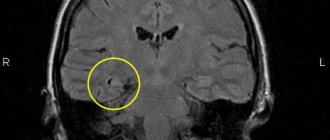Epilepsy is one of the most common neurological diseases diagnosed among women of childbearing age. In the United States, more than a million women have been diagnosed with epilepsy during their reproductive years. Every year, more than 24,000 children with the same diagnosis are born in perinatal centers, namely, up to five children per thousand births. Pregnant women with epilepsy generally feel normal, and specific complaints rarely occur.
Most patients give birth to healthy children; pregnancy does not affect the course of the disease or changes in symptoms. The frequency of attacks remains the same. To minimize the risk of complications during pregnancy, an individual treatment regimen is selected for each patient. Personalized therapy selected for a woman during this period will not only improve the prognosis for the mother, but also reduce the risk of developing the disease in the unborn child.
Introduction
The onset of pregnancy in a woman with epilepsy is not only a desirable, but also a very important stage of life.
Therefore, it is necessary for a patient of fertile age to be immediately explained upon her first visit to an epileptologist that this event, like any good impromptu event, must be planned. The ability to have children with epilepsy in women is reduced on average by 2 times compared to the general population. This is due to both social and organic reasons. Antiepileptic drugs (AEDs) can disrupt the functions of the endocrine system and provoke the development of sexual disorders (hypo- or hypersexuality), obesity, hypothyroidism, polycystic ovary syndrome, delayed sexual development, menstrual dysfunction and ovulation disorders.
Pregnancy is contraindicated only in women with severe epilepsy, when taking AEDs does not help to avoid frequent generalized seizures, in addition, the woman has severe mental disorders.
Epilepsy is not a contraindication to IVF, although we should not forget that to stimulate the production of eggs, women candidates for IVF undergo massive administration of hormonal drugs. This can sometimes trigger seizures.
Follow-up after pregnancy
If during pregnancy the concentration of antiepileptic drugs in the blood decreases, then after childbirth it usually increases. A neurologist-epileptologist carries out treatment adjustments.
The Institute of Child and Adult Neurology and Epilepsy named after St. Luke provides full support for pregnant women in the field of epileptology. Our doctors have helped dozens of women with epilepsy achieve their dream of having a child.
If necessary, it is possible to observe and treat a newborn baby by pediatric neurologists of our Institute, as well as conduct specialized developmental classes at the St. Luke Health and Development Center.
Preconception preparation for women with epilepsy
Pregravid (from Latin gravida
- pregnant) preparation - a set of preventive, diagnostic and therapeutic measures, the result of which is the readiness of future parents to fully conceive, bear and give birth to a healthy child. Planning a pregnancy is not just about taking vitamins, quitting drinking and smoking 1-2 months in advance. before conception. Preconception preparation begins 6–10 months in advance. before the desired pregnancy and includes a specific list of procedures.
Pregravid preparation takes place in several stages:
Medical examination of spouses.
Preparing a couple for conception, a woman for bearing a child.
Determining favorable days for conception.
The number and scope of studies before a planned pregnancy are determined for each patient individually by a therapist, gynecologist, or geneticist. From the point of view of an epileptologist, it is necessary to determine the concentrations of AEDs in the blood plasma; perform a general blood test to determine platelet levels; biochemical blood test to determine the level of ALT, AST, bilirubin, alkaline phosphatase; take an electroencephalogram (EEG) or conduct video-EEG monitoring. In some cases, when planning pregnancy, it is advisable to conduct an ultrasound examination of the uterus and its appendages, as well as a number of hormonal studies that reflect the function of the woman’s reproductive system. To select the dose of AED, regular testing of the concentration of the drug in the blood is indicated, and to maintain a constant concentration, it is advisable to use dosage forms with a slow release (durant forms).
An indication for an unscheduled determination of the concentration of AEDs in the blood before pregnancy is an increase in frequency/severity of attacks or the appearance of symptoms of intoxication.
During the preconception period, it is recommended to consult a geneticist to determine the risk of epilepsy in the unborn child. Epilepsy is not a hereditary disease, but in some cases it can be inherited. The risk of transmitting epilepsy to a child from mother with genetic epilepsies is on average 10%, with unknown etiology and structural epilepsy - 3%. The risk of paternal transmission of epilepsy is on average 2.5%. If both parents suffer from epilepsy, the risk of a child inheriting epilepsy increases to 10–12%. If a woman suffers from structural or unknown etiology epilepsy, the risk for the unborn child increases threefold compared to the general population, but in the case of genetic generalized or focal epilepsy - 10 times.
You need to undergo genetic testing if:
both partners in a couple have epilepsy;
the couple already has a child with epilepsy;
in the family, one or both parents had cases of epilepsy, developmental defects (congenital cleft palate or cleft lip, finger deformities, etc.) and hereditary diseases;
the patient had 2 or more spontaneous miscarriages, cases of fetal or newborn death.
The main goal of the doctor is to achieve complete control of the attacks before the desired pregnancy occurs. An important indicator is the duration of the absence of attacks in the patient before pregnancy: if for 9 months. If there are no seizures, then there is a very high probability that there will be no seizures during pregnancy. However, it is difficult to predict the course of each specific pregnancy.
It is not advisable to stop taking AEDs during the period of conception. A woman should be warned that the risk of developing congenital anomalies of the fetus while taking AEDs increases threefold, but that refusal to take the drug is fraught with even more serious consequences - injury or death of the fetus in the event of an epileptic seizure. It is necessary to explain to the patient that sudden cessation of taking AEDs sharply increases the risk of attacks, can lead to failure of remission, and increase the frequency of existing attacks.
The administration of folic acid is indicated to prevent pathological effects on the fetus and reduce the risk of miscarriage (spontaneous miscarriages). Folic acid supplements must be prescribed before the patient becomes pregnant, since for most women pregnancy itself is a surprise. It is recommended to start taking folic acid supplements 3 months in advance. before the expected pregnancy at a dosage of 3–5 mg/day and continue taking until 14 weeks. pregnancy. In addition to folic acid, the use of complex vitamin preparations recommended for pregnant women is also indicated. Anemia treatment is carried out before pregnancy with the use of drugs containing iron and folic acid.
Since sodium valproate is more likely than carbamazepine to have a teratogenic effect, and the combination of valproate and lamotrigine is especially dangerous, carbamazepine is the drug of choice, but only if there are no contraindications to its use (most forms of genetic generalized epilepsy, secondary bilateral synchronization on the EEG in patients with focal epilepsy). Information about the effect of “new” AEDs on the intrauterine development of the fetus is still insufficient, therefore, unless there is an urgent need, it is better to refrain from introducing them into therapy during the period of preparation for pregnancy.
The doctor is at a great disadvantage. By allowing a woman to become pregnant and give birth to a child, he takes on additional responsibility and new risks. If teratogenic consequences occur, the patient and her relatives will attribute this to the AEDs prescribed by the doctor; in case of exacerbation of the disease, the cause of suffering will be considered to be incorrectly selected therapy, and not the long-awaited pregnancy. In addition, the question of having a child in patients with epilepsy, for various reasons, does not arise at a very young age.
Features of management of pregnant women with epilepsy
At this period of life, the leading doctor is an obstetrician-gynecologist, with whom the patient should be regularly monitored. Until the 28th week. examinations are carried out once a month, from the 28th to the 36th week - once every 2 weeks, and after the 36th week. - every week. Throughout pregnancy, a woman should be observed by an epileptologist: with complete control of seizures - once every 2 months, with repeated partial seizures - once a month. The patient should be warned about the need to consult a doctor if attacks become more frequent. If there is any concomitant pathology: diabetes mellitus, anemia, arterial hypertension, kidney disease, etc., supervision of related specialists is required. Most gynecologists, neonatologists and pediatricians are very afraid of the negative effects of AEDs on the body of the mother and fetus, while at the same time they do not attach such importance to the drugs they prescribe. However, the prescription of AEDs is the competence of an epileptologist; changing the treatment regimen is possible only in agreement with him. If other specialists make adjustments to therapy or insist on discontinuing AEDs, then you need to inform your epileptologist about this.
Currently, there is no reliable data on the increased incidence of pregnancy complications (preeclampsia, arterial hypertension, spontaneous abortions, changes in the frequency of seizures, status epilepticus) in women with epilepsy taking AEDs compared to the general population.
During pregnancy, the minimum effective doses of AEDs should be used, preferably in monotherapy [1]. Taking one drug reduces the risk of possible fetal development defects. The dose of AEDs should be as low as possible, but one that does not cause generalized seizures. Changing the drug to an analogue may lead to an increase in attacks. It is recommended to continue taking the same drug from the same manufacturer.
An important safety factor is the use of drugs with controlled release of the active substance, which can be used 2 times a day. This eliminates concentration peaks that have a particularly adverse effect on the fetus.
Nausea and vomiting due to toxicosis can significantly complicate the use of AEDs. To avoid a decrease in the concentration of drugs in the blood, you can use intravenous or rectal forms. With frequent vomiting (up to 20 or more times a day), hospitalization is indicated.
Unfortunately, none of the “first aid drugs for seizures” are registered in Russia. The only available way to prevent an attack in Russian conditions is the use of diazepam tablets under the tongue when an attack is anticipated. Taking additional doses of AEDs, as a rule, does not make sense, since their absorption period is quite long.
Pregnant women are contraindicated in taking psychotropic drugs and strong sleeping pills. Sleep disorders should be treated with non-drug methods: herbal medicine (decoction of calamus, fireweed, oregano, chamomile, mint, linden, peony, etc.); psychotherapy (listening to quiet relaxing music before bed); aromatherapy; compliance with sleep hygiene, as well as work and rest regimes.
Fluoroquinolones are contraindicated in epilepsy. The use of some other groups of antibiotics and antimicrobials: macrolides, high doses of penicillins should also be avoided if possible. However, if inflammation is present, the benefit of antibiotic therapy may outweigh the risk.
Pregnant women with epilepsy are contraindicated for physiotherapy in the head and neck area.
Valproate intake is associated with weight gain. However, weight gain also occurs during pregnancy. In most cases it is impossible to say unequivocally what explains weight gain - taking valproate or an abnormal course of pregnancy. To correct body weight, observation by a gynecologist-endocrinologist and diet are indicated. Replacing valproate with another AED during pregnancy is not justified; it can lead to the occurrence/increase of attacks and is only permissible if absolutely necessary.
In 15–20% of women, the number of attacks may increase, more often in the first or third trimester of pregnancy. Increased seizure frequency cannot be predicted based on seizure type, duration of epilepsy, or increased frequency of seizures during a previous pregnancy. Even the presence of hormonal-dependent epilepsy is not a prognostic factor for increased frequency of epileptic seizures during pregnancy. The resumption of attacks may be due to the pharmacokinetics of AEDs during pregnancy.
The most common triggers for seizures during pregnancy are emotional stress and sleep deprivation. An increase in body temperature can provoke attacks and accelerate the elimination of AEDs. Hypoglycemia (low blood glucose levels) and alcohol consumption can also lead to the occurrence/increasing frequency of attacks. Seizures may become more frequent after a traumatic brain injury. Therefore, you need to lead a correct lifestyle, carefully monitor your health, and observe a work and rest schedule. However, quite often attacks occur completely unpredictably, and a “healthy lifestyle” does not prevent them. Therefore, it is necessary to take a sufficient dose of AEDs, and not just eliminate provoking factors.
Severe and moderate forms of ARVI or influenza aggravate the course of epilepsy and can provoke the appearance/increase in seizures. Despite this, specific prophylaxis (vaccination) is not recommended, because, firstly, the effect of a number of vaccines on the fetus has not been adequately studied, which means they are potentially dangerous for the fetus, and secondly, an adverse reaction to their introduction is an increase in temperature. To prevent influenza in pregnant women, natural immunomodulators (“folk remedies”) are used, as well as hygiene measures (avoid crowded places, wash your hands and face, wash your nose and eyes after returning from the street).
Generalized seizures are considered the most dangerous for both mother and child. During their development, many factors have a negative impact on the body of the mother and child. Focal seizures can generally be considered to have no impact, but it is important to remember that they can take a generalized form.
The study of the concentration of AEDs in the blood during pregnancy should be carried out repeatedly, at least once every 2 months, and in the case of recurring attacks - monthly. This must be done not only because during pregnancy the metabolism of AEDs or drug concentrations may change due to weight gain, but also to monitor compliance.
Plasma concentrations of lamotrigine may decrease significantly during pregnancy. Also, at the end of the first trimester, due to increased clearance, it may be necessary to increase the daily dosage of levetiracetam.
To assess the full functioning of the placenta and early diagnosis of fetoplacental insufficiency, it is advisable to study the hormones of the fetoplacental complex (placental lactogen, progesterone, estriol, cortisol) monthly from the end of the first trimester of pregnancy.
Particular attention is paid to the study of alpha-fetoprotein. At the end of the last century, it was found that in cases of neural tube defects in the fetus (anencephaly and spina bifida), the content of alpha-fetoprotein, a protein synthesized in the fetal liver, increases in the mother’s blood serum. With neural tube defects, alpha-fetoprotein penetrates through the capillary wall in the area of the defect into the amniotic fluid, and from there into the mother's bloodstream. With the introduction into clinical practice of a method for determining the level of alpha-fetoprotein in maternal blood serum, it was possible to increase the accuracy of diagnosing neural tube defects of the fetus. Thus, using this method, up to 97–98% of cases of anencephaly are detected. Determination of serum alpha-fetoprotein levels is also used to diagnose multiple pregnancies, anterior abdominal wall defects and other fetal malformations. It has been established that with Down syndrome in the fetus, the content of alpha-fetoprotein in the mother's blood serum decreases. Determination of alpha-fetoprotein levels is carried out at 15–20 weeks. pregnancy, the most informative study is at 16–18 weeks; it is repeated if changes are detected during ultrasound.
Fetal ultrasound is performed at 19–21 weeks. pregnancy to exclude developmental anomalies. A high level of alpha fetoprotein in the maternal serum is an absolute indication for fetal ultrasound.
An important diagnostic method is cardiotocography. This method allows you to obtain more objective information about the state of the fetal cardiovascular system compared to auscultation of heartbeats. Cardiotocography evaluates the fetal heart rate, its variability, the presence of accelerations (increased heart rate by 15–25 beats per minute during fetal movements) and decelerations (decrease in heart rate by no more than 30 seconds during contractions). The normal state of the fetus corresponds to a heart rate of 120–160 per minute, good heart rate variability (mainly due to accelerations) and the absence of high-amplitude decelerations. The value of this research method lies in the simultaneous determination of fetal heartbeats and uterine motility. The method allows you to diagnose intrauterine fetal hypoxia due to fetoplacental insufficiency.
The patient should warn the obstetrician that a number of medications are contraindicated for her: nootropics, analeptics, psychotropic drugs (with the exception of fractional administration of small doses of benzodiazepines in order to potentiate pain relief during childbirth).
Due to the potential for vitamin K deficiency when taking enzyme-inducing AEDs (carbamazepine) in the last weeks of pregnancy, it is advisable to prescribe vitamin K to a woman using these AEDs at a dose of 10–15 mg/day.
Epilepsy when planning pregnancy
The risks of seizures during pregnancy include various injuries, early birth, miscarriages, and antenatal fetal death. The attending neurologist-epileptologist discusses an action plan with the expectant mother. The doctor’s main task at this stage is the selection of monogenic antiepileptic therapy. It is important to understand that all drugs against epilepsy have a teratogenic effect, that is, they affect the fetus. This can lead to fetal malformations, as well as subsequent developmental disorders in the child.
That is why it is important to entrust the selection of therapy to a doctor familiar with specific approaches to antiepileptic therapy during pregnancy. The doctor selects the drug and its dosage, taking into account the minimum possible effect on the fetus while maintaining control of the disease. When weighing the risks for a pregnant woman and her unborn baby from taking antiepileptic drugs and the risks of uncontrolled epilepsy, modern medicine assesses the risk from the latter as much higher!
Features of the labor period in women with epilepsy
Women with epilepsy have a higher risk of bleeding, weak labor and preeclampsia (the risk of the latter is 2 times higher than in the population), placental abruption, premature birth; obstetrics are 2 times more likely to be carried out by vacuum extraction of the fetus or cesarean section. To reduce the risk of complications, it is necessary to establish complete control over attacks.
The likelihood of an epileptic seizure during labor and within 24 hours after birth is higher than the likelihood of an epileptic seizure during other periods of pregnancy. First of all, this is due to skipping an AED dose.
Epilepsy is not a contraindication for natural delivery, and drug management of labor and pain management do not differ from generally accepted standards. In most cases, long-term epidural analgesia can be used.
Indications for cesarean section are increased frequency of epileptic seizures, convulsive seizures more often than once a week. in the last trimester of pregnancy, serial or status epilepsy in the prenatal period, fetal hypoxia, weakness of labor, convulsive attack during childbirth.
Frequency of attacks during pregnancy
According to medical statistics, for many women the frequency of attacks during pregnancy remains the same or decreases. The period of gestation does not in any way affect the appearance of new signs of epilepsy or the worsening of the mother's condition. An increase in attacks is observed in up to 30% of cases in the first or third trimester of pregnancy, in which the body is more susceptible to changes.
It is impossible to predict changes in the frequency of attacks based on the patient's medical history. The duration of the pathology and the increased frequency of attacks during a previous pregnancy also do not affect the woman’s condition at the moment. The situation can change at any moment. Some patients have catamenial epilepsy. With this diagnosis, women experience attacks or become more frequent during certain phases of the menstrual cycle. Even with this form of the disease, it is impossible to predict an increase in epileptic seizures during pregnancy.
The following factors influence the frequency of seizures:
- nervous tension or emotional changes;
- impaired water-salt metabolism;
- disrupted hormonal levels or changes in hormonal levels;
- decrease in the level of antiepileptic drugs in the blood.
The expectant mother is advised to monitor the quality of her sleep and compliance with the prescribed course of treatment. If you experience frequent drowsiness or insomnia, you should definitely consult your doctor. Adjusting treatment on your own is strictly prohibited. Throughout pregnancy, the patient is required to visit an epileptologist who will monitor the condition and monitor changes. Only in this case can the occurrence of complications and the risk of congenital anomalies of the fetus be prevented.
Management of the postpartum period in women with epilepsy
The patient should be warned about the need to carefully follow the AED regimen during this period, since there is a risk of decompensation of epilepsy in the postpartum period due to physical overexertion, stress, increased drug load, and increased estrogen activity.
Also, after delivery, symptoms of an AED overdose may appear due to a decrease in the mother’s body weight, blood loss during childbirth, and metabolic changes. If symptoms of neurotoxicity appear - drowsiness, diplopia, nystagmus, ataxia, an urgent study of the concentration of AEDs in the blood is necessary. If the dosage of the drug was increased during pregnancy, it is advisable to return to the daily dose used before pregnancy. If the mother has no seizures and the child has no side effects from AEDs, changing the dose is not advisable. Another danger lies in the increased frequency of attacks due to child care and night awakenings.
Breastfeeding a newborn is quite possible, since the dose of AEDs that enter the child’s body with milk is not comparable to the amount of the drug entering the fetus’s body through the placenta. An exception should be made for phenobarbital and lamotrigine. The mechanisms for their elimination from the body of a newborn are unformed, which can lead to the accumulation of the drug [1].
AEDs acted on the fetus throughout pregnancy, and their content in breast milk was significantly lower than in the blood of a pregnant woman. In addition, you can reduce the amount of the drug in milk by taking AEDs after feeding.
The most common complication in newborns is skin manifestations in the form of allergic reactions. Cases of hemorrhagic complications (increased bleeding) have been described. The use of phenobarbital during pregnancy can lead to both sedative symptoms (drowsiness, weak sucking, muscle weakness, lethargy, lethargy) and withdrawal syndrome (motor agitation, restless sleep, frequent causeless crying), if for some reason breastfeeding milk stops.
If a newborn exhibits low activity, lethargy during feeding, gastrointestinal disorders and other symptoms suspicious of intoxication, then it is better to switch to artificial feeding.
Determining the concentration of the drug in breast milk has no practical meaning. It is much more important that the child has clinical manifestations of the effects of AEDs. The dose of the drug that reaches the baby through breast milk depends on the amount of milk sucked. In children over 6 months of age who have already been introduced to complementary foods, the dose of the drug received decreases as the child grows.
For children at high risk of seizures, an exemption from preventive vaccinations is provided. Vaccination is undesirable in the acute phase of infectious diseases accompanied by an increase in body temperature. Routine vaccination is postponed until the end of acute manifestations of the disease. It is possible to deviate from DTP vaccination or replace it with ADSM.
Women with epilepsy should breastfeed while lying on the bed or sitting on the floor, preferably in the presence of relatives. This will minimize the risk of injury to the mother and/or baby during an attack.
Planning and management of pregnancy in women with epilepsy
Issues of planning and managing pregnancy with concomitant chronic somatic and neurological pathologies are extremely relevant, taking into account the fact that the modern level of development of medicine makes it possible to achieve stable remission of the underlying disease. The ideal option is when the only reminder of the disease is regular medication use, and clinical manifestations of the pathology are practically absent. Against this background, a sick woman strives to be a full member of society and fully experience the joy of motherhood. It is very important that modern technical capabilities make it possible, using new non-invasive techniques, to monitor a developing pregnancy and objectively monitor a complex of morphometric, functional and biochemical indicators that reflect the development of pregnancy. However, in connection with the decision of a woman with epilepsy to have a child, obstetricians-gynecologists and doctors of related specialties often face a lot of problems.
Epilepsy is a chronic brain disease, in the treatment of which some progress has been made in recent years, in particular in the field of pregnancy management. The Department of Nervous Diseases of the Faculty of Medicine, together with the Moscow Regional Research Institute of Obstetrics and Gynecology, as a result of joint research, issued guidelines for the management of pregnancy in women with epilepsy [2].
Practical neurologists and epileptologists should carry out constant, systematic work among women with epilepsy, taking into account their possible motherhood. In our work, we discuss issues of contraception and pregnancy with the sick girl and her relatives, starting from puberty, so that they are fully informed about the problem. First of all, the issues of contraception are discussed. The fact is that all drugs with enzyme-inducing properties (carbamazepine, phenobarbital, hexamidine, benzonal, diphenine, ethosuximide) reduce the effectiveness of hormonal contraceptives, therefore the simultaneous use of antiepileptic drugs (AEDs) and combined estrogen-progestogen hormonal contraceptives in 8-10% of cases can lead to to the occurrence of unwanted pregnancy [7]. In this situation, it should be recommended to use a barrier method of contraception or use hormonal drugs with a high content of estrogen, but it is better to discuss this aspect with a gynecologist-endocrinologist. Drugs such as benzodiazepines, Depakine, Keppra, Lamictal, Topamax (the latter in a therapeutic dose of up to 200 mg/day) do not reduce the effectiveness of oral contraceptives, so their joint prescription with hormonal contraceptives does not reduce the effectiveness of the latter.
Regarding the problem of pregnancy directly, the attention of the woman herself and her relatives should first of all be focused on the fact that pregnancy in patients with epilepsy should be planned.
For a successful pregnancy in a woman with epilepsy, close cooperation between a neurologist, obstetrician-gynecologist, geneticist, therapist, the patient herself and her relatives is necessary.
The task of the neurologist is to select rational drug therapy, in which drug remission of the disease should be achieved using a minimum dosage of AEDs. Ideally, therapy should be carried out with one AED (monotherapy), using the lowest daily dose. Another important factor in the success and “safety” of therapy is the use of drugs with controlled release of the active substance (Depakine Chrono, Tegretol CR, Finlepsin retard). Due to the absence of significant fluctuations in the concentration of AEDs in the blood of durable forms of drugs, it is possible to eliminate the concentration peak, which has the most adverse effect in terms of teratogenicity, and with a significant drop in the level of the drug in the blood, an epileptic attack can develop. If an AED, with the use of which drug remission of the disease has been achieved, does not have a dosage form with a controlled release of the active substance, the daily dose should be distributed into more frequent divided doses to eliminate peaks in blood concentrations.
The main goal of drug treatment for epilepsy is to achieve remission of the disease. However, this does not mean at all that women with epilepsy should not become pregnant if they have recurring seizures. The fact is that focal epileptic seizures without secondary generalization are considered safe for the fetus. Therefore, if it was not possible to achieve complete remission of the disease, but it was possible to exclude generalized convulsive seizures, we can assume that the task of the preparatory stage by the neurologist has been partially solved. It should be remembered that there is a direct relationship between the dose of AEDs and the frequency of congenital deformities, as well as between the number of generalized seizures and the frequency of congenital anomalies; therefore, the goal of therapy is to achieve drug remission with a minimum dose of AEDs. If it is possible to exclude generalized convulsive seizures, and further increasing the dose of the drug does not lead to a significant effect, then one should limit oneself to this minimal therapy.
Generalized convulsive seizures are accompanied by severe anoxic-ischemic disorders, in particular of the uteroplacental circulation [3], so their frequent occurrence in the patient is a contraindication to pregnancy. In addition, contraindications to pregnancy are:
- intractable epilepsy with frequent generalized seizures;
- status of the disease;
- pronounced changes in the personality of a patient with epilepsy.
Pregnancy is indicated in the following cases:
- persistent drug remission of the disease;
- with subcompensation with rare attacks.
However, the prognosis of pregnancy outcome in correlation with the timing of single and rare generalized convulsive seizures has not yet been studied.
The task of the obstetrician-gynecologist is to achieve normalization of menstrual function (up to 40% of patients with focal epilepsy have various deviations in the duration and characteristics of the menstrual cycle). Anemia should be treated (according to our data, it is observed in patients with epilepsy in 37.2% of cases) [8]. It is preferable to use the drug ferro-foilgamma (1-2 capsules 3 times a day, in courses of up to 6 weeks). When taking drugs with enzyme-inducing properties (carbamazepine, phenobarbital, diphenine, etc.), it is possible to increase the level of enzymes (LDH, AST, ALT, GGT and alkaline phosphatase). It is recommended to use the hepatoprotector Essentiale (2 capsules 3 times a day, in courses of 4 weeks).
The task of a geneticist is to advise a pregnant woman in order to exclude hereditary pathologies. With idiopathic generalized epilepsy, the probability of a child inheriting epilepsy reaches 10%; with symptomatic partial epilepsy, it is slightly higher than in the population (2–3%).
A woman with epilepsy should regularly take AEDs and come for examination by a neurologist and obstetrician-gynecologist in accordance with the observation plan. Before conception and during the period up to 13 weeks of pregnancy, the patient should take folic acid in a daily dose of at least 3 mg, usually as part of a complex multivitamin preparation.
Observation scheme for pregnant women with epilepsy
In a compensated state of epilepsy with remission of epileptic seizures, the regularity of observation by a neurologist is once every 2 months, by an obstetrician-gynecologist - according to the standards. If partial seizures are observed, regular observation by a neurologist is once every 1 month; obstetrician-gynecologist - once every 2 weeks. Patients with epilepsy should know that they should contact an epileptologist if there is any increase in epileptic seizures. The reasons for the increased frequency or severity of seizures may be lack of sleep, somatic pathology, including positive water balance, violation of the medication regimen, etc.
An EEG study and determination of AED concentrations are carried out in case of compensated epilepsy once every 2 months, and in case of observed seizures - every time a pregnant woman visits a neurologist.
The concentrations of hormones of the fetoplacental complex (placental lactogen, progesterone, estriol, cortisol) and a-fetoprotein are examined starting from the end of the first trimester of pregnancy and thereafter at least once a month.
Dynamic ultrasound of the fetus is performed when a pregnant woman is registered, in the 19th–21st week (to exclude abnormalities of fetal development) and then once every 4 weeks. Starting from the 20th week of pregnancy, given the high risk of developing fetoplacental insufficiency, with ultrasound it is advisable to conduct a Doppler study of blood flow in the umbilical cord artery, aorta and middle cerebral artery of the fetus. When performing ultrasound fetometry, it is necessary to take into account the fact of the possible influence of AEDs on them.
Taking into account the certain risk of developing congenital pathology (all antiepileptic drugs are considered potentially teratogenic), consultation with a geneticist is mandatory before the 17th week of pregnancy and, if indicated, a chorionic villus biopsy, amniocentesis with determination of the concentration of a-fetoprotein in the amniotic fluid and a cytogenetic study are additionally performed.
Starting from the 26th week of pregnancy, a cardiotocographic study with an objective assessment of uterine motility indicators and the condition of the fetus is indicated.
Diagnosis and treatment of fetoplacental insufficiency is carried out according to standard regimens. Piracetam should be used with some caution due to the possible provocation of seizures.
In the case of compensated epilepsy, there are no special features in prenatal preparation. Indications for early delivery due to epilepsy are a tendency to serial seizures and status epilepticus.
Features of childbirth and the postpartum period
Epilepsy is not a contraindication for vaginal delivery. Status epilepticus, increased frequency of epileptic seizures in the prenatal period, as well as unfavorable negative dynamics of the fetal condition are indications for cesarean section.
Drug management of labor and pain relief for epilepsy does not differ from usual.
Contraindications to epidural anesthesia are very rare, in particular in cases of impaired circulation of cerebrospinal fluid due to a previous pathology involving the cerebrospinal fluid spaces.
Due to the risk of exacerbation of epilepsy in the postpartum period, regular use of AEDs and a rest regimen are strongly recommended.
A decrease in the need for AEDs after childbirth determines the likelihood of their overdose up to the development of intoxication. The appearance of drowsiness, nystagmus, and ataxia in a postpartum mother requires an urgent study of AED concentrations. AED intoxication is caused by a relative increase in AED concentration due to a decrease in the total weight of the woman in labor, blood loss during childbirth, changes in drug absorption and some other factors. Usually, in the postpartum period, it is enough to return to the daily dosage of AEDs used before pregnancy (in cases where the daily dosage of AEDs was increased during pregnancy).
According to the recommendations of international experts, immediately after the birth of a child, he needs to be given intramuscular vitamin K at a dosage of 1 mg/kg body weight [4].
If partial seizures persist, it is recommended that one of the relatives be constantly with the woman in labor.
Refusal to breastfeed a newborn is completely unjustified, since during pregnancy the exposure of AEDs to the baby’s blood is usually higher than in mother’s milk. Breastfeeding should be done in a supine position to avoid injury in the event of a seizure.
Let us list the main AEDs used in the treatment of pregnant women with epilepsy.
Valproic acid . The average daily dosage can range from 600–3000 mg (15–30 mg/kg/day or more), it is advisable to use a drug with a controlled release of the active substance Depakine Chrono and a 2-fold dose. According to the latest data obtained from population studies, a dosage of valproic acid up to 1000 mg/day does not have a teratogenic effect [5]. Taking valproic acid during pregnancy leads in 1–2% of cases to the development of a neural tube defect (spina bifida aperta) in newborns, and according to some data, the frequency of this pathology even reaches 2.5%. As a result of the drug's high affinity for transport proteins, its concentration in breast milk reaches only 2–3% - the lowest among currently used AEDs.
During pregnancy, the total concentration of valproic acid in the blood serum does not change significantly. The prescription of valproic acid in the first trimester of pregnancy due to the threat of defects in the development of the spinal cord should be carried out with caution, monitoring markers of CNS dysontogenesis (a-fetoprotein, acetylcholinesterase) and performing an ultrasound examination of the fetus in later stages of pregnancy.
Carbamazepine . Typically, adults are prescribed the drug in a dosage of 400-2400 mg/day (8–20 mg/kg/day). The minimum effective dose is used when taken 3-4 times during pregnancy or a form of the drug with prolonged release of the active substance (Tegretol CR, Finlepsin retard). Our studies have shown that the use of carbamazepine in a dosage of up to 10 mg/kg is often sufficient to compensate for epilepsy and at the same time does not affect the parameters of the fetoplacental complex [6]. Taking carbamazepine during pregnancy can lead to fetal malformations: congenital hip dislocation, inguinal hernia, hypospadias, congenital heart defects and spinal cord defects. The risk of a congenital neural tube defect when taking carbamazepine during pregnancy reaches 0.5–1.0%. The combined use of carbamazepine and valproic acid during pregnancy leads to the highest incidence of congenital malformations, so this combination should be avoided.
The pharmacokinetics of carbamazepine during pregnancy is characterized by the relative stability of the free fraction of the drug, and therefore in most cases there is no need to increase the dose of AEDs.
According to the latest data, the penetration of carbamazepine into mother's milk reaches 45% of the content in the blood.
Phenobarbital . The drug continues to be widely used in the treatment of epilepsy. Its daily dosage is usually 60–240 mg (1–3 mg/kg/day) when taken twice.
Belonging to the category of AEDs that induce the cytochrome P-450 system, phenobarbital, like carbamazepine, reduces the effectiveness of hormonal contraceptives. For the same reason, the drug can lead to vitamin K deficiency in newborns.
According to some data, during pregnancy the concentration of phenobarbital decreases in approximately 1/3–1/2 of all patients receiving monotherapy with the drug. In the postpartum period, on the contrary, its concentration can increase significantly. Therefore, despite the long half-life of the drug, it is recommended to monitor the dynamics of its concentration during pregnancy and the postpartum period: an increase in seizures, the appearance of signs of overdose or side effects require immediate dose adjustment.
According to the latest data, about 40% of the drug circulating in the mother’s blood enters breast milk. In newborns, due to the weakness of liver enzyme systems, the half-life of the drug can vary significantly from 75 to 275 hours, which must be taken into account when breastfeeding. The use of phenobarbital during pregnancy can lead to both sedative symptoms in the newborn (drowsiness, weak breastfeeding, muscle hypotension) and withdrawal syndrome if, for some reason, breastfeeding is not carried out or is interrupted.
Difenin (phenytoin). In recent years, this drug has been used less frequently, but continues to be used quite widely in practical medicine. The daily dosage of diphenine is usually 200–600 mg (4–7 mg/kg/day) taken 2–3 times. Classified as an enzyme-inducing AED, it can lead to vitamin K deficiency in the newborn.
The pharmacokinetics of phenytoin during pregnancy is characterized by a decrease in concentration mainly in the third trimester of pregnancy, especially when combined with other AEDs, so there may be a need to increase the dose. In the postpartum period, the dose of phenytoin should be reduced to the original dose.
Up to 20% of the drug circulating in the mother’s blood enters breast milk.
Currently, more and more information is emerging on the use of the latest generation of drugs during pregnancy. Experimental data indicate that the main adverse effects of “new” AEDs when used during pregnancy are slower growth and development of the fetus, as well as the development of skeletal malformations, in contrast to “old” AEDs, the use of which during pregnancy can lead to malformations of the orofacial region, congenital malformations of the cardiovascular and urogenital systems, as well as neural tube defects [1]. It should be remembered that therapy with two or more drugs significantly increases the risk of congenital malformations, so polytherapy during pregnancy should be avoided.
Using the proposed method, over 90 pregnant women suffering from epilepsy were observed over a 15-year period. 92% of children were born in satisfactory condition. The effectiveness of the proposed method of managing patients with epilepsy during pregnancy allows us to recommend it for widespread use in practical healthcare.
For questions regarding literature, please contact the editor.
P. N. Vlasov, Doctor of Medical Sciences, Professor MGMSU, Moscow
Preeclampsia and eclampsia in patients with epilepsy
Eclampsia is considered a condition characterized by the development of one or more generalized seizures in a woman with preeclampsia. In half of the cases, eclampsia develops before childbirth; the frequency of its occurrence during childbirth and in the postpartum period is approximately the same.
Preeclampsia is characterized by arterial hypertension with proteinuria and edema in the second half of pregnancy. The diagnosis of severe preeclampsia is made when one of the following criteria is present:
increase in systolic blood pressure more than 160 mm Hg. Art. or diastolic blood pressure more than 110 mm Hg. Art., registered twice with an interval of more than 6 hours;
loss of protein in urine more than 5 g/day or a sharply positive result of a rapid urine test for protein;
oliguria (urine amount below 400 ml/day);
severe headache (due to cerebral edema) or blurred vision (due to retinal edema or spasm of the retinal arteries);
signs of pulmonary edema and cyanosis.
Severe preeclampsia is an indication for immediate delivery. Seizures in eclampsia should be regarded as provoked, occurring against the background of acute brain damage. Encephalopathy in eclampsia develops as a result of impaired autoregulation of cerebral blood flow and increased capillary permeability. This leads to cerebral edema, the development of multiple microhemorrhages and disseminated intravascular coagulation, which is the cause of attacks. The risk of eclampsia is not always proportional to the severity of arterial hypertension. In young primiparous women with initial arterial hypotension, eclampsia can develop with an average blood pressure of 120–130 mm Hg. Art. Therefore, effective antihypertensive therapy is required in all cases of preeclampsia, although this does not have a significant effect on the transition to eclampsia. Among antihypertensive drugs, vasodilators should not be prescribed, since they have the ability to enhance the increase in perfusion cerebral edema.
Another area of therapy is seizure control. In the past, benzodiazepines and phenytoin were used to relieve attacks. Currently, a solution of magnesium sulfate is considered the most effective remedy. As a prophylactic agent for severe preeclampsia in the antenatal period, magnesium sulfate can be administered intramuscularly, or intravenously in the presence of seizures. The drug is administered intravenously in a slow stream at a dose of 4 g (16 ml of a 25% solution), and then 1 g (4 ml of a 25% solution) every hour during the day. On the first day, additional administration of 2–4 g of magnesium sulfate may be necessary if attacks continue. Subsequently, they switch to intramuscular administration of the drug.
During therapy, monitor the level of urine output (more than 100 ml/h), the frequency of respiratory movements (more than 12 per minute) and the preservation of tendon reflexes. A change in these indicators indicates the toxic effect of magnesium sulfate. To adjust the dosage, intravenous bolus injection of 10 ml of a 10% calcium gluconate solution is used. Calcium channel blockers (nifedipine) should not be prescribed together with magnesium sulfate due to the common mechanisms of action of these drugs.
If therapy with magnesium sulfate is ineffective, additional administration of a diazepam solution of 10 mg 1–2 times/day is used. The lack of effect of such therapy indicates the need for intravenous barbituric anesthesia.







